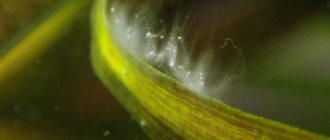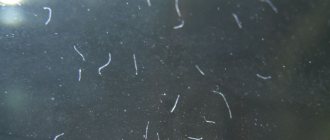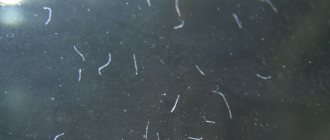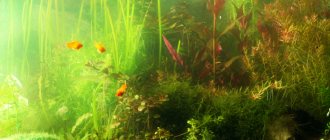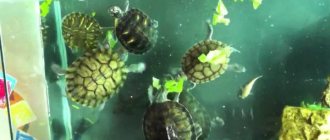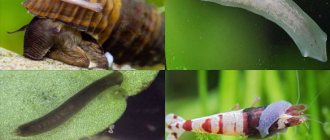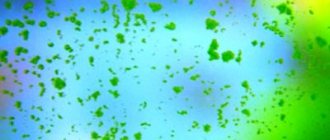Aquarium owners often encounter problems maintaining glass housing for fish. One of the most common problems is the formation of a film on the surface of the water in an aquarium. The phenomenon is dangerous for the inhabitants of artificial water spaces and is provoked by many factors. Every aquarium owner should know why an unpleasant oil film appears on the water surface and how to deal with it.
What is this and how can it affect fish?
Regardless of appearance, the presence of film is dangerous for aquarium fish for the following reasons:
It prevents light from “breaking through” the water and reaching the bottom. Both underwater plants suffer from its deficiency (as a result of which the aquarium ecosystem is disrupted) and the fish themselves (their growth and development slows down, immunity deteriorates).- The normal course of gas exchange is disrupted.
The oxygen content in water decreases. It is vital not only for fish, but also for saprophytic bacteria. Moreover, the latter consume its remains especially actively; due to the resulting deficiency, the local fauna and flora develop oxygen starvation. - Water from the aquarium evaporates less actively, and the thermal balance suffers. As its temperature rises, fish have breathing problems.
- The aquarium creates a microclimate favorable for the active reproduction of bacteria that feed on organic debris.
Ammonia released during the decomposition of organic matter is a poison for fish. Even if they survive the poisoning, their immunity will still be seriously affected. Infections that they previously tolerated without problems become deadly for the inhabitants of the aquarium.
Bacterial and organic films can be considered relatively “harmless” for fish.
It is much worse if it is chemical or oil-based. In this case, if nothing is done, intoxication and, most likely, death of the fish are almost inevitable.
Mechanical cleaning
This type of care is performed using a special plastic scraper, which can be purchased at any pet store. An alternative tool is the hard side of a kitchen sponge. Hard-to-reach areas are cleaned with a hard-bristled toothbrush. Despite the absence of chemicals, at the final stage the container should be rinsed to remove cleaning residues. A steam cleaner can be a replacement for a mechanical tool; steam softens the plaque and makes it easier to remove, but it will be useless against stone.
Important! It is undesirable to use metal tools; small particles of metal begin to rust, form a reddish coating and scratches on the walls, and harm the fish by getting into the esophagus.
What are the reasons for the appearance and ways to combat it?
It is not always possible to establish the specific cause of the described phenomenon . Often it is provoked by a whole complex of factors.
However, the problem of film on water must be solved in any case; most of the methods recommended for this are universal.
Stagnation of water
Often, a novice aquarist does not know at all that simply pouring water into a glass container and placing fish in it is not enough.
If the water is not mixed, its stagnation is closer to the surface and provokes the appearance of a film. To get rid of it, you need to collect what you already have with a sheet of paper .
Regular writing paper or whatman paper will do; it is better not to use napkins - they get wet very quickly. The sheet must be placed on the surface of the water, left for 10-15 seconds and carefully pulled out over the edge before it loses its shape and integrity.
Along with the paper, any film adhering to it is also removed from the aquarium. The procedure is repeated 3-4 times until the contamination is completely removed .
Further, to create a suitable ecosystem, special equipment is needed, including a compressor and filters.
Filtration and aeration systems ensure the saturation of the water in the aquarium with oxygen and the creation of surface flow. This helps remove pathogenic microflora and organic waste, preventing their appearance and development in the future.
This video will show you how to get rid of film on the water in an aquarium:
Covered due to feed decomposition
If you do not calculate food consumption rates according to the number and type of fish in the aquarium, but simply thoughtlessly pour in more, the “unclaimed” food will sink to the bottom .
To it are added waste products of fish and other inhabitants of the aquarium, particles of rotting algae, and other organic matter formed in the container. As a result of its processing by saprophytic bacteria, a film that is slimy to the touch, most often white, whitish or grayish in color, is formed on the surface of the water.
Here it will be useful to add ampullary, coil, Australian or bladder snails to the aquarium (at the rate of 2-3 pieces per 10 liters of water). These are natural “cleaners” of the water itself and the walls of the container. It takes 3-5 days for mollusks to clear the aquarium of any organic matter.
However, with such an abundance of food, the snail population is increasing at a rapid pace. Once the required result is achieved, it is recommended to forcibly reduce their number, otherwise they will begin to eat algae.
Viviparous fish (guppies, mollies, penicillia) cope somewhat worse with the task of cleaning their “home” , but there is also a positive effect.
Soil acidification
It is provoked by pebbles placed on the bottom. Water gradually “washes” acids out of them, which enter into a chemical reaction with other substances contained in it.
The result of this “interaction” is carbon dioxide . Bubbles of carbon dioxide rise upward, “dragging” microparticles of organic waste there.
Existing film can be removed using a sheet of paper. To maintain the acid-base balance, follow a partial water change schedule. You can understand that it is time by using rapid tests. A strip of paper soaked in a reagent moistened with water from an aquarium shows its pH.
Finding a radiator nearby
In this regard, not any radiators and other heating devices are dangerous for an aquarium, but only oil radiators. If the aquarium is close enough to them and is not closed with a lid, or is not closed tightly, oil vapors generated when the radiator is heated settle and condense on the surface of the water, turning into a greasy, shiny film.
An oil film is the most dangerous for fish, so you need to act quickly in this case. It is best to resort to medication.
Antibiotics (for example, Biomycin) are added to the water . One tablet is enough for 10 liters of water.
All fauna must be temporarily “relocated” somewhere before the cleaning procedure. It is also necessary to study the instructions for the selected drug in advance and follow the instructions given therein.
Poor quality artificial plants
Another possible source of chemicals is unsafe aquarium decor.
This applies not only to artificial algae, but also to any structures . Toxic glue protruding from the seams, paint, and other materials used in their manufacture may well poison the water.
Even ordinary dirt can cause film formation. Therefore, before installing any decor on the bottom of the aquarium, you need to thoroughly wash and disinfect it, choosing products that will not harm its inhabitants and water.
To solve this problem, it is best to use a UV sterilizer . This multifunctional device helps to get rid not only of plaque on the surface of the water, but also of pathogenic microflora (viruses, bacteria) and unicellular algae living in the aquarium.
Before processing fish and other aquarium inhabitants, they must be transferred to another container. The device is installed above the aquarium or close to it, water is sucked inside using the pressure difference. There it passes through a filter and is disinfected by ultraviolet rays.
Appears due to chemicals and drugs
Chemicals in aquarium water most often appear as a result of recently carried out repairs , if drying oil, paint (no matter nitro or oil), glue, or special putty were used in the process.
All this, upon contact with water, inevitably dissolves in it. The result of the reaction is microparticles of toxic substances that gradually float to the surface of the aquarium.
This film leaves an oily feeling on your fingers, and when light hits it, it casts all the colors of the spectrum, turning into a rainbow.
Medicines are sometimes used to purify aquarium water. But if the drug is chosen without taking into account its rigidity, chemical composition, or the dosage is violated, uncontrolled reactions are possible, as a result of which a film appears that tightens the surface.
To get rid of “one-time” drug contamination, it is recommended to purchase and connect an extractor . Essentially, this is a high quality filter. It is fixed on one of the walls of the aquarium and looks like a rectangular or cylindrical container.
The device sucks in surface water and releases it back through a 3-stage filter system. Other chemicals are combated with antibiotics.
Seaweed
We are not talking about “classic” aquarium vegetation, but about microscopic algae belonging to the blue-green class.
The intensive development of cyanobacteria is provoked by increased brightness of light , especially in combination with stagnant water, and neglect of cleaning the “fish house”.
As a result, rapidly reproducing single-celled algae, striving for light and warmth, float higher, collecting in a film on the water.
If the problem is noticed in time, snails are quite capable of containing algae proliferation. When the water is already in full bloom, it is better to immediately use an extractor or UV sterilizer.
Personal experience
An example of the successful use of improvised substances is the use of 70% acetic acid. In addition, cotton pads and half a razor blade were prepared. To clean glass walls
- the discs were periodically wetted with acid;
- areas of contamination were wiped;
- After wiping, areas with heavy deposits were additionally cleaned with a blade.
The surface is quickly cleaned; in most cases, the blade turned out to be superfluous. After the procedure, the internal cavity must be thoroughly washed. The acid is concentrated, even a minimal amount can harm flora and fauna.
Important! Acetic acid of this concentration gives a strong odor, so it is advisable to clean it in a well-ventilated area.
How to prevent it from happening in the future?
Problems with film on the water can be completely avoided if you study in advance the important nuances of caring for the aquarium and its inhabitants and regularly carry out simple procedures:
- Purchase artificial algae and other aquarium decor only if the seller has a quality certificate confirming its safety for fish and other fauna. Before placing in the aquarium, the decorations must be washed with water to remove dust and dirt.
- Do not climb into the aquarium with your hands unless absolutely necessary. If this is still necessary, first wash them with clean water, without soap.
- Always cover the container with a lid to prevent dust from settling on the surface of the water. But at the same time, a noticeable gap is necessary for normal air exchange.
Partially change the water every 7-10 days.
If the aquarium is relatively small, it is enough to drain and refill 10-20% of the total volume. In containers over 70 liters, the “norm” increases to 25-30%. Tap water will not work; you need to let it sit for at least 3 days. Immediately before this, it is necessary to clear the soil at the bottom of fish waste and other organic matter using a siphon.- Adjust the dose of food so that the fish eat it completely within 3-5 minutes.
If you see that residues are settling on the bottom, you need to remove them immediately. Food in the form of granules is the best option for the aquarist. However, they are selected by size. Excessively small granules simply “spill out” through the gills, settle on the bottom; large fish are unable to swallow, so they spit them back out. You can also use live food (daphnia, bloodworms), but also taking into account the size of the inhabitants of the aquarium. - If possible, add “orderlies” (viviparous fish, snails). The former are incompatible with “fighting”, predatory fish, simply species characterized by aggressive behavior. In addition to mollusks to remove plaque from the walls and film from the surface of the water, it is recommended to also add melania snails to the aquarium, which clean and loosen the substrate at the bottom.
The listed activities will help create an ecosystem suitable for fish and maintain its biological balance. A novice aquarist should not neglect prevention, so that he does not have to deal with problems later.
Prevention
What to do to prevent the appearance of film:
- cover the tank with a lid to prevent exposure to radiator batteries and dust particles;
- clean the aquarium in a timely manner and change the water;
- periodically siphon the soil;
- use high-quality decor, wash it before lowering it to the bottom;
- control the degree of aeration;
- Avoid overfeeding the fish, causing uneaten food to fall to the bottom.
By adhering to the rules of prevention, it is easy to prevent the appearance of a film on the surface of the aquarium water. The owner must remember: with high-quality maintenance of the aquarium, a problem cannot arise.
Cleaning an aquarium without draining the water
It is possible to remove not too old limescale deposits from glass without relocating the aquarium inhabitants. This method is close to mechanical cleaning:
- filters, internal lighting and aeration systems are removed and washed;
- Contaminated areas are cleaned with a special scraper;
- 10 to 70% of the water is pumped out and replaced, depending on the frequency of maintenance.
After completion of the service, all equipment is returned to its original location. This method is well suited for removing fresh deposits that have not yet turned into water stone. In the latter case, you will need to choose more serious and effective methods.
Important! The need to clean the aeration system can be easily checked by the float. The last one can be any floating little thing. Immerse the float in water; if its position does not change within 10 minutes, the system needs urgent care.
